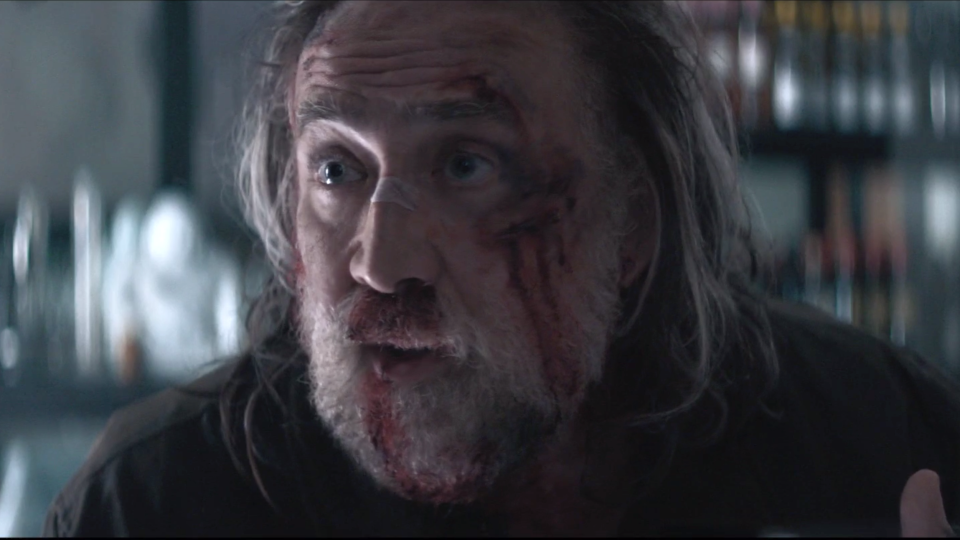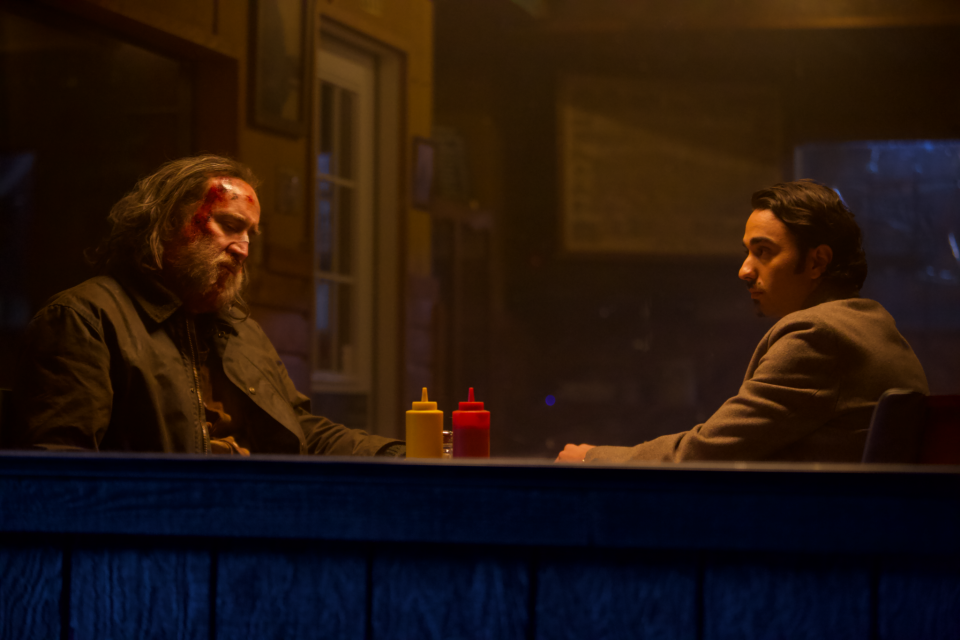Nic Cage’s Worries About His Cat Fueled His ‘Haiku’ of a Performance in ‘Pig’ — Q&A

- Oops!Something went wrong.Please try again later.
- Oops!Something went wrong.Please try again later.
- Oops!Something went wrong.Please try again later.
Quiet is not the word that comes to mind when you think of Nicolas Cage. Neither is Oscar. But love him or leave him, Cage was nominated for an Oscar for playing twins in “Adaptation” (directed by Spike Jonze from Charlie Kaufman’s script) and won for his sullen alcoholic in Mike Figgis’ “Leaving Las Vegas.” He has given many more bravura performances over his career, among them Norman Jewison’s romantic Cher vehicle “Moonstruck,” the Coens’ classic comedy “Raising Arizona” opposite Holly Hunter, Martin Scorsese and Paul Schrader’s “Bringing Out the Dead,” and John Woo thriller “Face/Off,” which Cage would love to reprise in a sequel.
He also carried his share of noisy Hollywood actioners, from “Con Air,” “Gone in 60 Seconds,” and “The Rock” to “Snake Eyes” and “National Treasure.” Cage steps up with a strong script and director, so it’s welcome news that the 57-year-old veteran — who has struggled with spending beyond his means, forcing him to work for lucre in B movies like “Ghost Rider,” “The Lord of War,” and “The Wicker Man” — recently decided to change direction.
More from IndieWire
Sundance Is a Virtual Market for VOD Movies, and They're Better for It (Column)
Nicolas Cage Defends 'Operatic' Film Performances: 'Naturalism Is a Style'
The result is the recently released “Pig,”which was completed just before the pandemic and marks his best performance in years. Its 82 Metascore is Cage’s best since Panos Cosmatos’ “Mandy,” David Gordon Green’s “Joe,” and my personal favorite, Werner Herzog’s “Bad Lieutenant: Port of Call New Orleans.” Cage even landed a Critics Choice Best Actor nomination.
“He’s a wonderful actor. There’s something great about him,” Herzog once told IndieWire. Agreed. In “Pig,” a bearded Cage combines an intimidating physical presence with a slow-burn performance as Rob, an introverted, once-renowned chef slowly coming back to life as he leaves rural isolation to track down his beloved stolen truffle pig in Portland, Oregon.
Here’s my (edited) conversation with Cage and “Pig” writer-director Michael Sarnoski, who makes his directing debut.

Anne Thompson: What was appealing to you about playing such a restrained character?
Nicolas Cage: At the time that I met with Michael, and we had a quiet and meaningful conversation over shishito peppers, I had read his script… which resonated with me as a haiku. With Japanese haiku, you have 5-7-5 syllables. [They] convey the space between. It’s evocative and those spaces become more meaningful than the words themselves. The way Michael wrote the script, I felt it would lend itself to the kind of film performance I wanted to get back to.
Why?
I had largely explored western Kabuki — what could be done with film performance in terms of the abstract and operatic and breaking form — and I wanted to get back to expression in film performance. That, for me, was why I became an actor. I was always interested in the work of James Dean and in the quiet performances of “Ordinary People” or “Midnight Cowboy.” I felt it had been a while. I needed to remind myself and some folks in the audience: “That was fun, and let’s get back to this.”
Did you relate to this wounded shut-in?
Cage: I was at a point in my own life when I understood the feeling of loss. I understood the profound connection you can have with our animal brothers and sisters. I was always close with my cat. I had a terrible nightmare [after] I read the script: I had lost my cat Merlin, something horrible happened. I felt, “I can play this organically, authentically, I don’t need to go and force it.” Lo and behold when I got on set, it just came out. It was the right place and the right time for that kind of director-actor-protagonist relationship. It just flowed.
Nic has become known for big, operatic performances. Why did you think he’d be right for this film?
Michael Sarnoski: After that first lunch we said, “This makes sense, we get it.” On set, it was not a performance that needed to be coaxed out. He understood the script and character. Everything in the movie he did in one or two takes.

Neon/Claire Timmons
Why did Nic wear one outfit for the entire movie, caked in layers of blood and grime?
Sarnoski: We did a makeup test in the hotel room with Pamela Warden trying different prosthetic pieces. The producers were giving me shit: “This is nonsense that no one would comment on his bloodiness throughout the film.” We meant it to be hyper-real. We got a casual coffee in the hotel bar. No one said a word that he was covered in bruises and blood. “See, that’s Portland for you!”
Cage: It would be rude to comment! People were afraid to say something about my appearance. The character was the right one to inhabit at that time in my life. I was feeling a little weighty and feeling some loss, the fear of society, all those things. It was easy. I didn’t have to go and find Rob. I did not demand to be called Rob on set. For me, Rob and Nic were one and they were blending together. I’d go back to sense memory in some recent situations, my dreams of my cat, that was on my mind: God forbid something happened to my cat like what happened to Brandy the pig. It was a genuine fear and concern.
Did you bond with the pig?
Cage: Brandy, sadly, is no longer with us. She, like many of us, is payment-oriented. Need a soulful look? Show a carrot off camera. Hit your mark? Some food over there. Michael and our excellent director of photography’s way of shooting, what information they wanted to put in the frame, added weight to the relationship between Rob and Brandy. It never lapsed into schmaltz or a sappy Hallmark card. Michael was observant of the relationship and brought the audience into the wilderness with the two of them in way that was gentle and neutral, which makes it more meaningful. It wasn’t to try to get you to feel something. It was more matter of fact.
I was unaware of a Portland underworld of chef-boxing. Where did that stem from?
Sarnoski: I hope that’s not real! It stemmed from a combination of things. People who work in restaurants do tend to get abused and exhausted. On location trips, we checked out restaurants in Portland and talked to a chef. “What do you do to unwind after work?” There was a lot of stress there. “I really like to punch a punching bag.” They are abused all day by higher-ups and customers. How you do want to take it out and feel powerful somewhere? How do you get a sense of control over your inner lives in the face of powerlessness or grief? It made sense that lower-level restaurant people come here to use what they had to get power and control. There are underground tunnels in Portland, which had a lot of organized crime in the ’50s. It has a storied underground history.
Did you study gastronomy and high-end cuisine in order to produce your perfect meal?
Cage: Michael suggested I read “The Devil in the Kitchen” by Marco Pierre White. I got a sense of the tension of the culinary industry, the terrifying level of high pressure they’re under. This is an art form where you’re ingesting the art. So much pressure for the client to not get sick, to make sure it tastes great. Nothing is more important than the food. You see where they lose it. Two chefs taught me how to make a mushroom tart and squab. I give my culinary teachers respect. I hope that comes through, the love of the food in the hands, the time we take and the way we present the food.
The movie is more than a man on a mission to commit violence or revenge, although yes, he wants to find his pig. It’s more cerebral and thoughtful.
Sarnoski: It’s not John Wick with a pig. Neon’s trailer does capture the vibe: it’s heightened a little bit; people bring that expectation into it. That’s part of the fun to play with that. You’re not sure what will happen. It might set people up for a surprise.
Cage: There might be fun to be had. Some of the audience is thinking it’s one thing and going on this journey, this road trip and discovering something else. I can’t think of a movie more further removed from “John Wick” than “Pig.” There’s not one gunshot in “Pig.” It’s a haiku of cinema, quiet, an in-depth character analysis that relies heavily on the ambience and the photography and the quietude of all the performances and the writing. It is not a tale of revenge. I like that. I understand that it’s a different kind of movie. Adventure films rely heavily on violence as one of the main sources of stimulation. I have made my share of those movies, but it’s wrong for some folks to think that’s what they’re going to get again, because I’ve explored different kinds of genres. I am happy to say this was a departure from that.
”Pig” opened in select theaters on July 16, 2021, and is streaming on Hulu.
Best of IndieWire
2021 Emmys Winners List: 'Ted Lasso,' 'The Crown,' and 'The Queen's Gambit' Lead the Night
2021 Emmy Predictions: Who Will Win at the Primetime Emmy Awards?
Emmy Predictions: Best Limited Series — Was It 'The Queen's Gambit' All Along?
Sign up for Indiewire's Newsletter. For the latest news, follow us on Facebook, Twitter, and Instagram.

